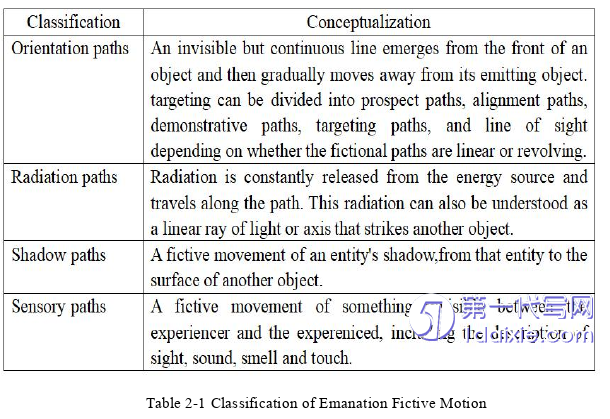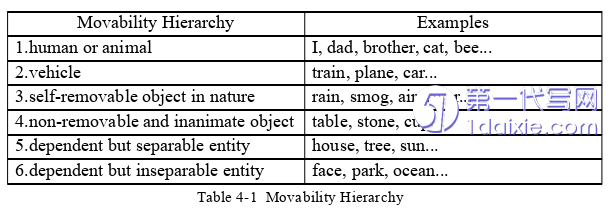本文是一篇英语论文,本文的贡献在于:(1)从词汇化模式研究英汉散射型虚拟位移表达的异同,为语言对比提供了新的视角,也为汉语语言类型的界定提供了范例。(2)本文就依照分析得出的词汇化模式总结了英汉散射型虚拟位移表达式的句法结构,这不仅可以加深我们对这个语言现象的认识,也可以为与语言教学和英汉互译等方面的研究提供帮助。
Chapter One Introduction
1.1 Background

The concept of fictive motion was first proposed by Talmy(1975)and called“virtual motion”.Then it was officially named“fictive motion”(Talmy,1996)and made aextensive discussion by Talmy(2000a).It refers to“the cognitive representation ofnonveridical phenomena-instances that depict motion with no physical occurrence”(Talmy2000a).Langacker(1987)named it“Abstract Motion”and Matsumoto(1996a,1996b)also called it“figureive motion”.Then,Talmy(2000a)systematically classifies fictive motion according to the characteristics of path.It mainly covers six categories,which are“emanation paths”,“pattern paths”,“frame-relative path”,“advent paths”,“access paths”,and“co-extension paths".
Scholars(Talmy2000a,Langacker1987,Fauconnier1997,Lakoff&Turner1989)found that fictive motion has an important relationship with human cognition.Talmy(2000a)proposed that the linguistic system uses fictional rays to represent thefictional motion of the perceptual system and pointed out that fiction motion is a uniquepattern of“over-lapping systems”in cognition.Langacker(1987)has specificallypointed out that fiction motion is the product of figureivism.The linguistic phenomenonof fictive motion occurs when sequential scanning is used to observe a stationarysituation.Fauconnier(1997)argued that the semantic expression of fictive motion is aprocess of concept synthesis,that is,according to the information correspondencebetween two input Spaces,new inferences will be generated in the Blend space.Lakoff&Turner(1989)argued that fictive motion expressions reflect the cross-domainmapping.The conceptualization of fictive motion is licensed by the motion metaphor interms of factive motion.
1.2 Objectives and Significance
The thesis has two objectives.To begin with of all,there is a kind of specificassociation between meaning and linguistic form of emanation fiction motion in eachlanguages.Based on the previous study,this thesis prove the emanation fictive motion isa type of motion event.It includes the conceptual elements figure,ground,and path inEnglish and Chinese.It can offer a better way for people to understand deeply thesemantic features in emanation expressions respectively.Secondly,the LexicalizationPattern Theory mainly introduce the lexcicalized features of each conceptual elements.Based on comparison and analysis,it is known that there are similarities and differences of lexicalization between English and Chinese emanation expressions,which reflects onthe patterns of motion and path.
Based on the background that are mentioned in the first part,this thesis bringssignificance from the perspectives of theory and practice.
Theoretically,this study provides a new perspective for the cross-language study ofemanation fictive motion.Under the cognitive semantics,this thesis analyzes theconceptual elements such as figure,motion,path and ground in English-Chineseemanation fictive motion expressions under the framework of lexicalization pattern,which is a new attempt to study the form-meaning interaction.Moreover,the research inthis thesis has certain significance for the typology,for Chinese emanation fictivemotion expressions share the features of Satellite-language.
Chapter Two Literature Review
2.1 Emanation Fictive Motion
As a common sentence structure,emanation expressions can be seen in many kindsof languages.This part mainly reviews the definition and basic characteristics of,aswell as classification of English and Chinese emanation sentences in order to make asolid foundation to the core of the thesis.
2.1.1 Definition
It is necessary to have an introduction to fictive motion before knowing theemanation fictive motion.
Fictive motion is a term that used to describe the static state of things by movingverbs.It is also commonly used in domestic studies.The terms imaginary movement,imaginative movement,or virtual movement sentences are often used to describe thisphenomenon.Fictive motion exists in the spatial sphere,as opposed to real movement,and is typically perceived visually,but not actually occurring.Talmy believes that thereis a“systematic cross-cognition continuum”that can be used to describe unrealphenomena.Under this continuum,various languages also show similarities anddifferences in sensory and expression due to the specific features of cognitive systems.Talmy(2000a)finally defines the concept of fictive motion as the representation ofwhat is actually perceived as a static referent as motion in the literal sense of thesentence.This study argues that the phenomena occurring in both visual perception andmental perception are perceptions of non-real motion phenomena through the action ofhuman cognition,with no actual motion occurring,and are both fictive motion.
2.2 Theoretical Studies on English and Chinese EFM
Emanation fictive motion expressions exist commonly in English and Chinese,andattract many linguists to study due to its frequent usage and special structure.In previoustheoretical studies,most of the scholars started from ontology research and cognitivemechanism behind it.
2.2.1 Ontology Research
Talmy,Langacker and Fauconnier were the early linguists who started working onfictive motion.
Talmy(1972)first noticed this linguistic phenomenon.He placed that fictivemotion exists on the human cognitive system and pointed out that fictive motion is thespecific manifestation of the"overlapping systems"in the cognitive system based on thelanguage.Fictive motion expression integrates reality representation and virtualrepresentation together.The description of a static entity is given a dynamic semanticcharacter.He can be regarded as the first linguist abroad who began to study fictivemotion in depth and was the founder of fictive motion.Leonard Talmy systematicallyanalyzed the cognitive representation,theoretical framework,and category of fictitiousmovement of fictive motion in Cognitive Semantics(Volume I):Concept ConstructionSystems and Cognitive Semantics(Volume II):Types and Processes of ConceptConstruction,which laid the foundation of cognitive semantics.In a series of fictivemotion categories,the emanation fictive motion which has not been studied is studieddeeply.Talmy divided emanation fictive motion into four categories,includingorientation path,sensory path,radiation path,shadow path,which are introduce above.Talmy(1996)also pointed out the cognitive principles for determining source object infictive motion:entities with higher positivity and determinism are easy to beconstructed as the source object of fictive motion;On the contrary,the less positive andless decisive entity is constructed as the end point of virtual movement.In"Toward aCognitive Semantics"published in 2000,Talmy expanded on the 1996 thesis andincluded it in a chapter devoted to emanation fictive motion.Meanwhile,the movingevent framework theory proposed by him is an indispensable theoretical basis for thestudy of emanation fictive motion.
Chapter Three Motion Event Frame Theory...................................25
3.1 Definition...........................25
3.1.1 Event....................................25
3.1.2 Motion Event.............................28
Chapter Four Comparison of EFM Between English and Chinese.........................40
4.1 The Analysis of Lexicalization Patterns of Conceptual Elements in EFM........40
4.1.1 Figure and Ground....................................40
4.1.1.1 Figure and Ground in English EFM........................43
4.1.1.2 Figure and Ground in Chinese EFM..............................47
Chapter Five Conclusion...............................73
5.1 Major Findings.....................................73
5.2 Limitations and Suggestions.............................74
Chapter Four Comparison of EFM Between Englishand Chinese
4.1 The Analysis of Lexicalization Patterns of ConceptualElements in EFM
The chapter will compare English and Chinese emanation expressions in terms ofseveral conceptual components,such as figure,manner,path and ground.Then,in eachcomparative dimension,we first consider the features of English emanation pathsentences,and then use them as a benchmark to discuss the features and representationsof Chinese emanation fictive motion expressions.This choice of the direction ofcomparison from English to Chinese is based on a consideration of previous studies ofemanation expressions.English emanation expressions have been studied mostly,sothis chapter chooses emanation sentences as the starting point for comparison.
Therefore the main task this chapter is to know the lexicalization of conceptualelements in English-Chinese and depict the similarities and difference.
4.1.1 Figure and Ground
In Talmy’s view,the figure and the ground are two basic components relating toeach other in space in motion event.The figure is a moving conceptually movable entitywhich is the basic element.The Ground is a reference entity,which clarifes figure's path,site,or orientation is characterized(Talmy,2000a).

Chapter Five Conclusion
5.1 Major Findings
According to Talmy's motion event frame theory,the author believes thatemanation fictive motion belongs to a kind of motion event,which is very common inChinese and Chinese.Figure,ground,motion and path are essential and basicconceptual elements of a motion event.Therefore,on the basis of previous researchresults of emanation fictive motion,the author has analyzed the representation of theconceptual elements in English and Chinese,and then make a comparison from theperspectives of Tamly's theory of lexicalization patterns.After the discussion,the majorfindings are as followings.
Firstly,from the perspective of similarity that exists in English and Chineseemanation fictive motion,the author find that the lexicalization pattern of figure andground in English and Chinese is similar,they represent as a noun or a noun phrase,andthe figure can be omitted or hidden in the source objects.Motion is usually semanticallyclosely related to path and formed as verbs or prepositional phrase.The path is the coreelement in the expressions of emanation fictive motion in English and Chinese,whichplays the role of constructing the core element in the sentence.
Secondly,from the perspective of difference that exists in English and Chineseemanation fictive motion.The author discovers that compared with English,Chinese ismore detailed in describing the characteristics of the figure(or source object),and theposition of ground information in the sentence is more flexible.About the motionelement,manner verb or path verb is feasible in Chinese.By contrast,path verb plussatellite components can represent motion in English.In terms of path information,English belongs to verb-preposition structure,which is usually completed with prepositional phrases.Chinese,on the other hand,belongs to verb-direction structure.The path information is usually completed by simple directional verbs or compounddirectional verbs,and the path is also described in more detail by preposition in Chinese.Moreover,when describing a complex path,Chinese will use multiple separate verbs toaccompany,while English will use a single verb with multiple prepositions.
reference(omitted)
